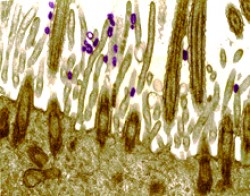Learning What H5N1 Needs to Spread
Learning What H5N1 Needs to Spread
Just a few mutations allow the avian H5N1 influenza virus to spread through the air, according to a new study. Another recent report found that 4 mutations and a genetic reassortment also enable airborne transmission. These insights will help researchers prepare for potential future flu pandemics.

Influenza viruses (purple) infecting cells of the upper respiratory tract.Image by R. Dourmashkin, Wellcome Images. All rights reserved by Wellcome Images.
Influenza, or flu, claims thousands of lives nationwide each year and hospitalizes more than 200,000. Health experts are concerned about the threat posed by the avian flu virus known as H5N1. The virus originated in birds, but some strains are now able to infect humans—and have caused a high rate of mortality in people who’ve been infected. To date, the viruses haven’t spread easily between people, but influenza viruses constantly change, or mutate. If lethal H5N1 viruses became more easily transmissible among humans, they could cause a worldwide flu pandemic.
A team led by Dr. Ron A. M. Fouchier of Erasmus Medical Center in Rotterdam, the Netherlands, set out to understand the mutations that would enable H5N1 to move easily between humans. Their study was funded in part by NIH’s National Institute of Allergy and Infectious Diseases (NIAID).
The scientists began with an H5N1 virus isolated from a victim in Indonesia. They first introduced 3 genetic mutations previously shown to help flu viruses spread. One was in a virus protein called basic polymerase 2 (PB2). The others were in hemagglutinin (HA), a protein on the virus surface that allows it to enter and spread from cell to cell. The scientists used these viruses to infect ferrets, which are considered the best influenza animal model. After a few days, they took nasal samples and infected other ferrets with these collected viruses. They passed the viruses through a total of 10 ferrets and then tested whether ferrets in adjacent cages could become infected without direct contact.
The researchers reported in Science on June 22, 2012, that several ferrets had been infected by airborne transmission of the H5N1 viruses. All the viruses still harbored the mutations the scientists had originally introduced. The viruses also had several other mutations. Only 2 of these changes, both in HA, were consistently found in all the airborne-transmissible viruses.
None of the identified viruses were lethal to the ferrets after airborne transmission. The viruses were sensitive to the antiviral drug oseltamivir and also reacted well with antibodies from ferrets that had been vaccinated against H5N1 strains.
In another NIH-funded study, which appeared in Nature online on May 2, 2012, a different research team also reported creating an H5N1 virus that could move between ferrets by airborne transmission. That team—led by Dr. Yoshihiro Kawaoka of the University of Wisconsin, Madison, and the University of Tokyo—created the virus with 4 HA mutations and the exchange of gene segments with a 2009 pandemic H1N1 virus.
“Both of these studies provide important insight into how H5N1 could mutate into a potentially pandemic-causing virus,” says NIAID Dr. Director Anthony S. Fauci. “Their publication in full is of great benefit to the public health and far outweighs the potential risks.”
By Harrison Wein, Ph.D.
###
* The above story is reprinted from materials provided by National Institutes of Health (NIH)
** The National Institutes of Health (NIH) , a part of the U.S. Department of Health and Human Services, is the nation’s medical research agency—making important discoveries that improve health and save lives. The National Institutes of Health is made up of 27 different components called Institutes and Centers. Each has its own specific research agenda. All but three of these components receive their funding directly from Congress, and administrate their own budgets.




















